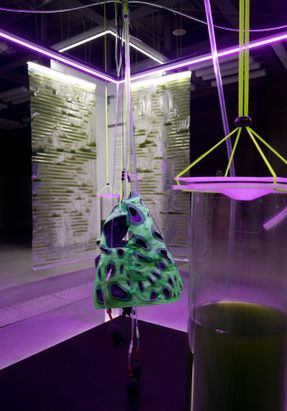
AirBubble Playground
ARCHITECTS
Ecologicstudio
LOCATION
Warszawa, Poland
CATEGORY
Installations & Structures
YEAR
2021
CITY
Warszawa
PHOTOGRAPHS
Maja Wirkus
STRUCTURAL ENGINEER
YIP London
BIOLOGICAL MEDIUM
Ecoduna
PROJECT TEAM
Claudia Pasquero, Marco Poletto with Eirini Tsomokou, Korbinian Enzinger,
Riccardo Mangili, Georgios Drakontaeidis, Alessandra Poletto
EXHIBITION TEAM
Claudia Pasquero, Marco Poletto with Eirini Tsomokou, Korbinian Enzinger,
Terezia Greskova, Stephan Sigl, Alessandra Poletto
ACADEMIC PARTNERS
Synthetic Landscape Lab IOUD Innsbruck University, Urban Morphogenesis Lab BPRO The Bartlett UCL
WOOD STRUCTURE
ArchWood
ETFE MEMBRANE
Temme
COUNTRY
Poland
AirBubble creates a purified microclimate for children to play in, a true bubble of clean air in the centre of Warsaw (Poland).
The project is located within the public green space outside of the Copernicus Science Centre (Centrum Nauki Kopernik), a site that will also host a dedicated exhibition illustrating the design innovation behind the invention of AirBubble.
The playground integrates the Photo. Synthetica technology for the advanced integration of photosynthesis in the built environment.
According to the World Health Organization (WHO), air pollution is the biggest global health threat. Warsaw was selected as the first activation for this project as it is one of the most polluted cities in Europe.
AirBubble invents a new architectural typology. It incorporates a cylindrical timber structure wrapped in an ETFE membrane protecting 52 glass algae reactors. This creates a real urban algae greenhouse.
The space is equipped with ropes, foot pumps, and bouncy spheres, and can function as both playground and outdoor classroom.
The white bubbling noise of the algae gardening system masks the surrounding urban noise to provide a calming atmosphere in which to play and interact.
The filtering process is enhanced by the architectural morphology of the playground structure.
The ETFE membrane – an evolution of the PhotoSynthetica urban curtain system presented in Dublin in 2018 by ecoLogicStudio – controls the microclimate inside AirBubble.
The inverted conical roof membrane further stimulates the air recirculation and natural ventilation, which in turn keeps the play area clean.
The AirBubble monitoring system integrates urban air pollution sensors and is connected to a data processing platform capable of comparing measurements in real-time and of highlighting the Air Quality Index for six core pollutants: fine particulates PM2.5 and PM10, ground-level Ozone (O3), Nitrogen Dioxide (NO2), Sulphur Dioxide (SO2) and Carbon Monoxide (CO).
AirBubble is capable of absorbing 97% of the nitrogen and 75% of the particulate matter in the air.
Early data collected in May 2021 shows concentrations of PM2.5 within the playground have fallen well within the recommended WHO limits (green zone, AQI below 20).
The peak reduction rate is an impressive 83%. This figure has been calculated by comparing readings from a pollution sensor located outside AirBubble with real-time data feeds from a monitoring device placed inside.
The monitoring phase will continue throughout the summer and into the autumn to verify these promising achievements over a longer period of time, under different climatic conditions and patterns of use.
Over the next few months, AirBubble will become a unique urban laboratory, a testbed of applied biotechnology and its application in tackling air pollution and in mitigating its effect on children’s health.
The AirBubble hosts 52 large bioreactors in borosilicate glass which contain 520 litres of living green Chlorella sp algae cultures that can filter a flow of polluted air of 200 litres/minute. While the liquid medium washes particles, the algae actively eat the polluting molecules as well as carbon dioxide to then release fresh clean oxygen.
The purifying process is powered by solar energy and children's playfulness. Kids can interact by jumping on four water foot pumps positioned on the ground while balancing on the bouncy bubbles and the internal rope system.
To mark the inauguration of the first-ever AirBubble, ecoLogicStudio has designed an interactive multimedia exhibition at the Copernicus Science Centre (Centrum Nauki Kopernik), illustrating the architectural innovation and biotechnology at the heart of the playground system.
The exhibition is composed of three areas: Monitor explores urban air pollution from the unique perspective of children's health. Purify the air reveals the powerful symbiosis of architecture and living microorganisms, and focuses on the filtration and re-metabolization of air pollutants. Breathe engages kids in an interactive demonstration of how to heal their bodies and our cities through the energy of play and breathing clean air.

























